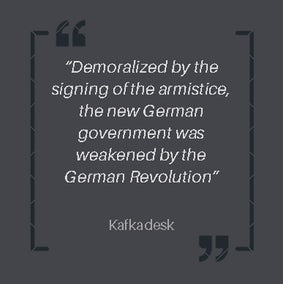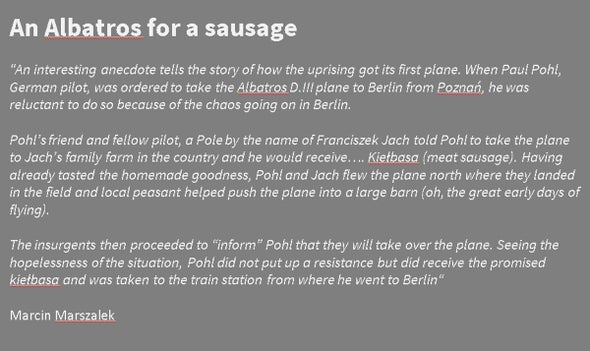A national uprising

Polish and German population in the Poznań Province.
Background
At the end of the First World War, a series of negotiations took place regarding the transferring of territories, border agreements and the formation of new states. Predictably, little of these discussions went smoothly, particularly as several countries stood to lose territory.
Timeline of Polish conflicts after the First World War.
Germany had signed the Treaty of Brest-Litovsk with Russia which settled the boundaries between the two countries. Built into that agreement was the understanding that a future Polish state – the Second Polish Republic – would come into existence.
Given that historically, the Polish lands had changed hands and be under the control of different nations, it was clear that this could be a complex issue. At the end of the First World War, Germany controlled part of it, with Austro-Hungary Empire controlling the rest of the – as it was the known – the Kingdom of Poland.
Map of the historic region of Greater Poland—the region's borders are outlined in red.
Poznań
The city of Poznań (German name: Posen) lay in German controlled territory yet – it had been a province of the Kingdom of Prussia since 1848 yet had a high Polish population, around 60%, and this population hoped to come under the control of the new Polish state.
In late 1918, Wilhelm II’s abdicated the throne of the Germany, which brought an end to the German Empire which was replaced with the Weimar Republic. The Polish population in Poznań started to plan for an uprising.

Black Reichswehr fighting Polish forces during the Poland Uprising 1919.
Wikipedia
The uprising begins
On 27 December 1918, the famous Polish pianist and nationalist, Ignacy Paderewski, made a rousing, patriotic speech in Poznań which sparked off the uprising.
The rebels consisted of members of the Polish Military Organisation (founded by future Polish leader Józef Pilsudski) mostly hardened veterans of the First World War, who formed themselves in a Citizens Guard.
The uprising was centred around the Bazar hotel, which was guarded by a 100-strong force from wildecka kompania Straży Ludowej (Wilda's People's Guard) led by Antoni Wysocki. A ruling body was set up - the Naczelna Rada Ludowa (Supreme People's Council). Central Command was created to oversee all military matters: troops, supplies, logistics etc and was commanded by a Major Taczak.

Aware that something was brewing, the Germans organised a protest:

Polish officers in Poznań
The Poles had timed their uprising well as the Germans were dealing with their own internal issues – the German Revolution had broken out.
They had their own mutinies to deal with and the new Weimar government struggled to control the country. The last thing it needed was another rebellion occurring.

Directions of insurgent activities from late December to mid-January 1919.
The first shots were fired late afternoon – although it is unclear who fired first: The Poles or soldiers from the German 6th Grenadier Regiment. As the shooting started, the Germans retreated to the nearby museum which was located next to the Polish strongpoint in the Bazar hotel. More Poles joined the fray and outnumbered, the Germans started to be forced back. The Poles quickly captures the post office, regency building and main railway station. Sporadic fighting broke out elsewhere across the city: as Chwaliszewo bridge, the area next to the municipal gasworks at Ogrodowa. In the days that followed, the Poles made more gains:


Caught off guard, the Germans struggled to respond effectively. They underestimated the size of the uprising, and their own command structure was affected when the Poles captured the commanders of the 5th Army Corps and the highest-ranking German officials. With their military and civilian leaders in captivity, they struggled to organise.
The Poles had effectively taken control of Poznań at the cost of only 8 dead and 20 wounded.
Polish units in Poznań
The uprising spreads
With the success of the Poles in Poznań, the uprising started to spread across the whole region.
Surrounding towns quickly organised themselves, irregular battalions and companies with democratically appointed leaders and named after local areas : Gołańcz company, Stęszew company, Powidz company, the Śrem battalion and the Gniezno battalion.
On 18 January 1919, Central Command organised Polish forces into separate fronts:
- The Northern Front: from the border with the Kingdom of Poland near Inowrocław to the Białe Lake near Czarnków; commander: Lieutenant Colonel Kazimierz Grudzielski;
- The Western Front: from the Białe Lake to the Obra Canal near Wolsztyn; commander: Colonel Michał Milewski;
- The South-Western Front (also called the “Leszno Group”): from the Obra Channel to Poniec; commander: Second Lieutenant Bernard Śliwiński;
- The Southern Front: from Poniec along the border with the Silesian province, to the border with the Kingdom of Poland, with Second Lieutenant Władysław Wawrzyniak as commander.
On 18 February, this was then reorganised and reduced to three separate districts.
- The Northern Front: poviats: Wieleń, Czarnków, Piła, Chodzież, Wyrzysk, Bydgoszcz, Wągrowiec, Gniezno, Witkowo, Żnin, Szubin, Inowrocław and Strzelno.
- The Western Front: poviats: Poznań – East, Poznań – West, Oborniki, Szamotuły, Międzychód, Skwierzyna, Nowy Tomyśl, Międzyrzecz, Babimost, Kościan, Grodzisk, Śmigiel, Leszno and Wschowa.
- The Southern Front: poviats: Gostyń, Rawicz, Koźmin, Krotoszyn, Śrem, Jarocin, Pleszew, Września, Środa, Ostrów Wlkp., Odolanów, Kępno and Ostrzeszów.
Some Polish units headed to Poznań to support the uprising in the main city:
Organisational structure of the Staff of Polish Central Command as of 8 January 1919.
South and Southeast
The uprising spread east and southeast up to the border with Russia, the Poles taking effective control of Września, Gniezno and Witkowo. German attempts to respond failed, with one sizeable force of 400 men, 30 machine guns and an artillery battle repulsed at the Battle of Zdziechowa.
With this success, the uprising continued to gain pace: More Polish units were formed at Trzemeszno, Kruszwica, Mogilno and Strzelno;
On 1 January, a volunteer unit, led by Second Lieutenant Paweł Cyms, headed for Kuyavia and Bydgoszcz;
On 5-6 January, a large Polish force of over 900 men – supported by two companies of the regular Polish army - liberated Inowrocław, suffering heavy losses but forcing the Germans to withdraw.
Polish machine gunners during the uprising.
North
In Northern Greater Poland, the uprising continued to spread like wildfire, as town after town took up the cause:

Unlike in other areas though, the Poles met with mixed success: On 2-8 January at the First Battle of Szubin – due to poor organisation and lack of coordination, the Poles attempts to gain controlled ended in abject failure with. It was clear in this area; the Germans held the tactical advantage and had sufficient forces to hold the town: In response, a large group of Polish insurgents launched a second, more successful assault at the Second Battle of Szubin on 11-12 January, which resulted in the Germans being expelled from Szubin, Żnin, Łabiszyn and Złotniki Kujawskie, and liberated the whole of the North eastern Greater Poland region.
By 15 January, the Poles had gained control of nearly all the province and were fighting desperate German attempts to regain control. The weakened German army had to rely on the assistance of irregular units such as the Grenzschutz. Fighting continued until the Treaty of Versailles was signed on 28 June 1919.
Polish soldiers in trenches on the Polish-German front, January 1919.
Wikipedia
Aftermath
The timing and success of the uprising influenced the proceedings at Versailles to such an extent that not only did the Poles get to keep Poznań, but Poland was also awarded the German cities of Bydgoszcz (Bromberg), Leszno (Lissa) and Rawicz (Rawitsch) – as well as lands which formed the Polish Corridor (and which separated East Prussia from the rest of Germany).
Although the Weimar Republic formed on policy on this separation of German territory, the reclaiming of these lands – and the reunification of Germany - would become one of the focuses of Hitler when he came to power in the 1930’s. Although the Nazi’s were to initially respect the boundaries of Poland’s territory in the non-aggression pact of 1934, with Pilsudski’s death in 1935 – Germany would eventually withdraw from this pact and eventually invade Poland, leading to the Second World War.
Further Reading
Sources:
Wikipedia
https://militaryhistorynow.com/2012/11/29/military-multi-tasking-poland-fights-five-wars-at-once/
Palatka daily news. November 14, 1919
Dr. T. Szulc - Kodeks dyplomatyczny Wielkopolski obejmujący dokumenta tak już drukowane, jak dotąd nie ogłoszone, sięgające do roku 1400, t.4, Poznań 1881 - Mapa Wielkopolski
Adam Szelagowski "Wiek XX', Warszawa 1937
Janusz Karwat
Marek Rezler
Paweł Anders
Bogusław Polak
Greater Poland Uprising 1918-1919
The Greater Poland Army - Insurgent Troops - Greater Poland Uprising 1918-1919
Greater Poland Uprising 1919 | The Polish Center of Discovery & Learning






















